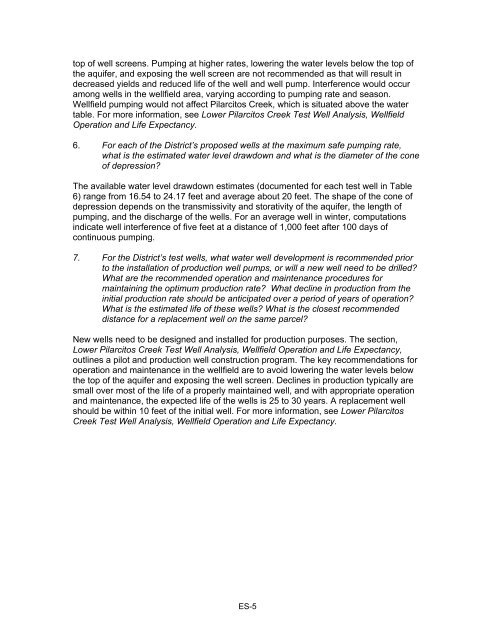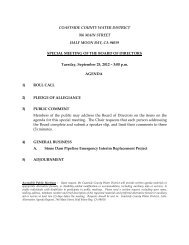Lower Pilarcitos Creek Groundwater Basin Study - Coastside ...
Lower Pilarcitos Creek Groundwater Basin Study - Coastside ...
Lower Pilarcitos Creek Groundwater Basin Study - Coastside ...
You also want an ePaper? Increase the reach of your titles
YUMPU automatically turns print PDFs into web optimized ePapers that Google loves.
top of well screens. Pumping at higher rates, lowering the water levels below the top of<br />
the aquifer, and exposing the well screen are not recommended as that will result in<br />
decreased yields and reduced life of the well and well pump. Interference would occur<br />
among wells in the wellfield area, varying according to pumping rate and season.<br />
Wellfield pumping would not affect <strong>Pilarcitos</strong> <strong>Creek</strong>, which is situated above the water<br />
table. For more information, see <strong>Lower</strong> <strong>Pilarcitos</strong> <strong>Creek</strong> Test Well Analysis, Wellfield<br />
Operation and Life Expectancy.<br />
6. For each of the District’s proposed wells at the maximum safe pumping rate,<br />
what is the estimated water level drawdown and what is the diameter of the cone<br />
of depression<br />
The available water level drawdown estimates (documented for each test well in Table<br />
6) range from 16.54 to 24.17 feet and average about 20 feet. The shape of the cone of<br />
depression depends on the transmissivity and storativity of the aquifer, the length of<br />
pumping, and the discharge of the wells. For an average well in winter, computations<br />
indicate well interference of five feet at a distance of 1,000 feet after 100 days of<br />
continuous pumping.<br />
7. For the District’s test wells, what water well development is recommended prior<br />
to the installation of production well pumps, or will a new well need to be drilled<br />
What are the recommended operation and maintenance procedures for<br />
maintaining the optimum production rate What decline in production from the<br />
initial production rate should be anticipated over a period of years of operation<br />
What is the estimated life of these wells What is the closest recommended<br />
distance for a replacement well on the same parcel<br />
New wells need to be designed and installed for production purposes. The section,<br />
<strong>Lower</strong> <strong>Pilarcitos</strong> <strong>Creek</strong> Test Well Analysis, Wellfield Operation and Life Expectancy,<br />
outlines a pilot and production well construction program. The key recommendations for<br />
operation and maintenance in the wellfield are to avoid lowering the water levels below<br />
the top of the aquifer and exposing the well screen. Declines in production typically are<br />
small over most of the life of a properly maintained well, and with appropriate operation<br />
and maintenance, the expected life of the wells is 25 to 30 years. A replacement well<br />
should be within 10 feet of the initial well. For more information, see <strong>Lower</strong> <strong>Pilarcitos</strong><br />
<strong>Creek</strong> Test Well Analysis, Wellfield Operation and Life Expectancy.<br />
ES-5



